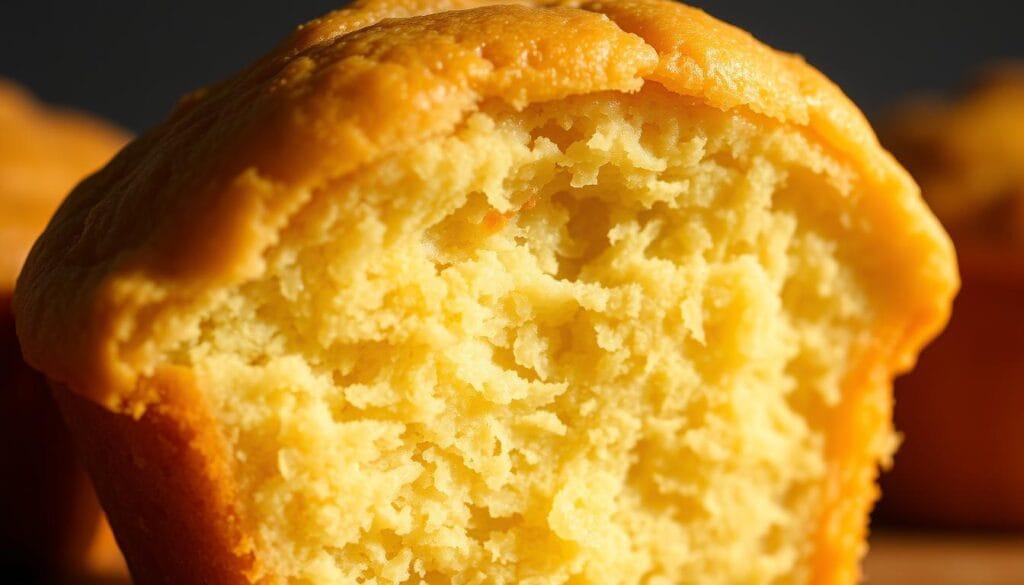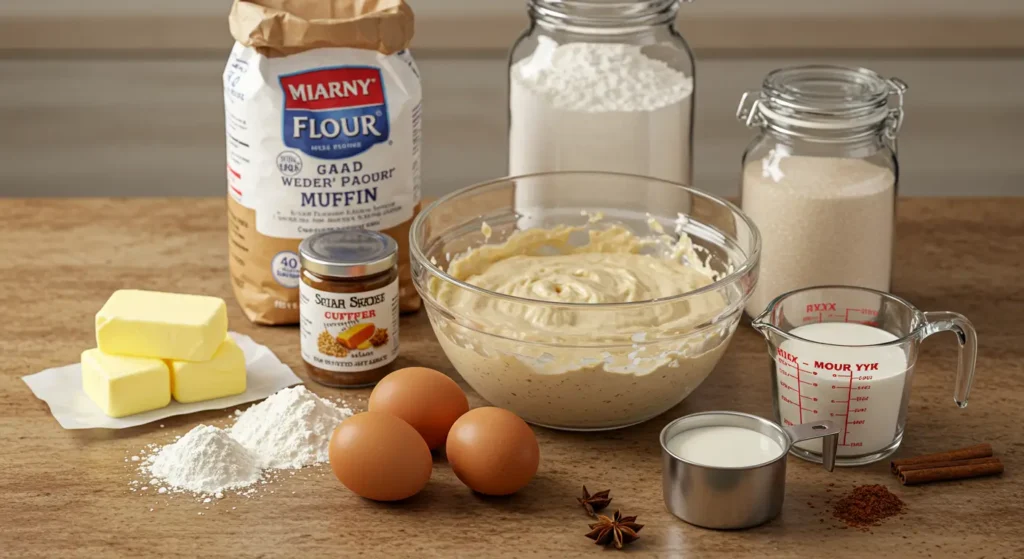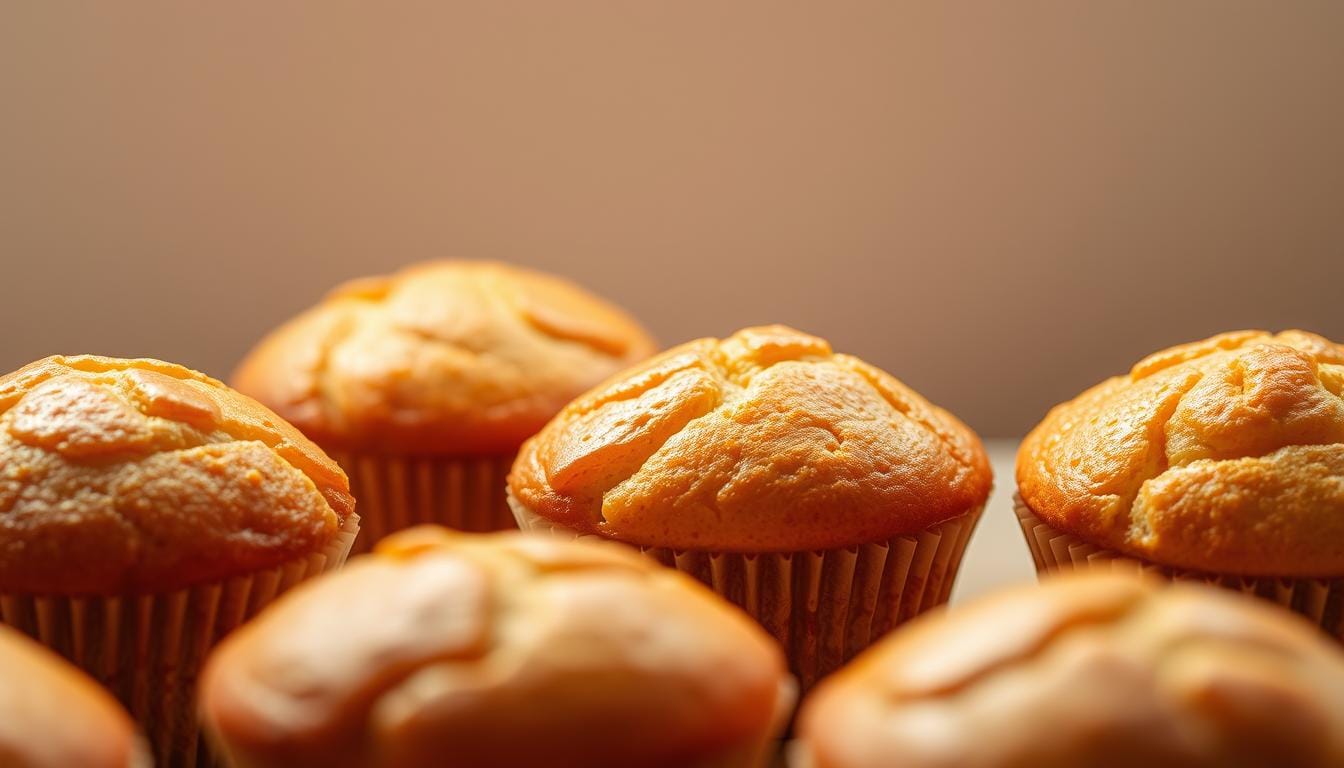What makes a muffin unforgettable? Is it the perfect texture, the right sweetness, or a mix of moistness and baking secrets? You might have tried many recipes but finding that perfect texture can be tough. The secret to moist muffins is in the baking science and the right ingredients and techniques.
By mastering these, you can make moist muffins with a perfect texture. Everyone will want more of them.
Exploring baking, you’ll find that the perfect muffin texture comes from hydration, fat, leavening agents, and mixing. With the right ingredients and techniques, you can make moist muffins that taste great and look good too. So, what are the baking secrets for moist muffins, and how can you use them in your baking? It’s all about understanding moisture in muffins and using the right ingredients and techniques for a perfect texture.
Table of Contents
Understanding the Importance of Moisture in Muffins
Getting the right moisture level is key when baking muffins. Moisture affects the texture and quality of muffins. You want them to be soft, fluffy, and tender, not dry and crumbly.
Overmixing is a big reason muffins can become dry. It develops the gluten in the flour, making the muffins tough. Baking them at the wrong temperature can also cause dryness. Not using enough liquid ingredients is another common mistake.

To avoid these issues, follow baking tips and guidelines. Use the right amount of liquid, don’t overmix, and bake at the correct temperature. Using high-quality ingredients like fresh fruits and nuts can also improve the taste and texture.
Some common causes of dry muffins include:
- Overmixing the batter
- Incorrect oven temperature
- Insufficient liquid ingredients
By avoiding these mistakes and following the right baking tips, you can make moist, delicious muffins. Whether you’re new to baking or have experience, understanding moisture is key to success.
Key Ingredients for Moist Muffins
For moist and fluffy muffins, the right ingredients are key. You need to pick the right flour, sweeteners, and fats. Cake flour makes muffins softer than all-purpose flour. Sweeteners like sugar and honey add moisture. Fats like butter and oil make the crumb tender.
A good muffin recipe has 1 cup of liquid for every 2 cups of flour. For each cup of flour, add 1 teaspoon of baking powder or 1/4 teaspoon of baking soda. One large egg is enough for 1–1.5 cups of flour. These ingredients, along with the right moist ingredients, make perfect muffins.
Some key ingredients for moist muffins include:
- Fats such as butter, oil, or cream
- Sweeteners like sugar, honey, or maple syrup
- Flour types, including all-purpose, cake, or whole wheat
- Moist ingredients such as eggs, milk, or yogurt

Choosing the right ingredients makes delicious, moist muffins. Don’t overmix the batter. Fill muffin cups no more than 3/4 full for even baking and a tender crumb.
Techniques for Keeping Muffins Moist
Techniques for Keeping Muffins Moist
To get the perfect muffin, mastering certain techniques is key. Start by using mixing methods that avoid overmixing. This can make muffins dense and dry. The right baking time and temperature are also important for texture and structure.
Most recipes use a 12-cup muffin pan. Each cup should hold about 1/3 cup. Adjusting baking time for larger or smaller muffins can help. Greasing the muffin tin and filling cups 1/2 to 2/3 full prevents sticking and ensures even baking.
Remember to arrange muffin cups in a 2-1-2-1 pattern for better air flow. Letting muffins cool for 3-5 minutes in the pan before removing helps prevent soggy bottoms. By following these tips and using the right mixing methods, baking time, temperature, and muffin tin, you’ll get moist and tasty muffins.
The Benefits of Adding Fruits and Vegetables
Adding fruits and vegetables to muffins can change the game. They bring natural sweetness and flavor. Plus, they add moisture, making your muffins even better.
Popular choices include bananas, apples, and carrots. They’re not just tasty; they’re also full of nutrients and fiber. Bananas are rich in potassium, while apples are full of antioxidants. Carrots, on the other hand, are packed with vitamin A and beta-carotene.
Popular Moisture-Boosting Add-Ins
- Bananas: rich in potassium and natural sweetness
- Apples: high in antioxidants and fiber
- Carrots: rich in vitamin A and beta-carotene
To make the most of fruits and vegetables, prepare them well. Wash, peel, and chop them into small pieces. You can also juice or blend them to add to your batter.
How to Prepare Fruits and Vegetables
Adding fruits and vegetables to your muffins makes them moist and flavorful. Try using bananas, apples, or carrots to elevate your muffins. See the difference for yourself!
The Impact of Eggs on Muffin Texture
Eggs are key in baking muffins, affecting their texture and moisture. Some recipes use more eggs for fluffier, moist muffins. Others use just one or none at all.
The size of eggs also matters. Large eggs weigh about 50 grams, while medium eggs are slightly less. Extra large eggs have a bit more volume. This size difference can change the muffin’s moisture level.
If you’re looking for egg substitutes, there are many options. One egg is like 50 grams of unsweetened apple sauce. A flax egg is made by mixing 1 tablespoon of flax meal with 3 tablespoons of water, resting for 10 minutes. You can also use mashed banana, avocado, or plant-based milk with vinegar. These substitutes help keep muffins moist and fluffy, even for those with dietary needs.
Some popular egg substitutes include:
- Flaxseed
- Applesauce
- Mashed banana
- Avocado
- Plant-based milk with vinegar
These alternatives help you get the right moisture and texture in your muffins, even with egg substitutes.
Secrets of Using Dairy Products
Dairy products are key in baking muffins, adding both texture and flavor. You can use milk, buttermilk, yogurt, and sour cream for a moist treat. Buttermilk and yogurt bring acidity and moisture, while sour cream improves texture and taste.
Adding dairy to your muffin recipe can greatly enhance the result. For example, milk makes the muffin tender. Buttermilk adds a tangy taste. Yogurt and sour cream add moisture and a rich flavor.
Using dairy in muffin recipes has many benefits. It adds moisture and flavor, improves texture, and makes the crumb tender. It also gives a rich, creamy taste. Try different dairy products to find the best mix for your muffins. Whether it’s milk, buttermilk, yogurt, or sour cream, you’ll get a delicious, moist muffin.
The Influence of Mixing and Baking Techniques
Mixing techniques are key to perfect muffins. Overmixing makes muffins dense and dry. But, resting the batter relaxes gluten, making them tender.
To avoid overmixing, mix dry and wet ingredients separately. Then, gently fold them together. This keeps the ingredients’ delicate structure intact, ensuring a tender muffin.
Baking techniques like temperature and time are also vital. Fill muffin cups 3/4 full and use a two-temperature baking method for better height. Letting muffins rest in the pan for 5 to 10 minutes before cooling helps prevent breakage.
Mastering these mixing techniques and baking techniques leads to moist, delicious muffins. They will surely impress your friends and family.
- Coat fresh fruit in all-purpose flour to minimize sinking
- Use a cookie scoop or ice cream scoop for even distribution of batter
- Space muffins appropriately in the pan to prevent uneven baking
By following these tips and avoiding overmixing, you’ll make perfect muffins every time. Always use room temperature eggs and gentle folding to keep your ingredients’ texture delicate.
Storage Tips for Maintaining Muffin Freshness
To keep your muffins fresh, follow these storage tips. Muffins stay fresh for 3-4 days at room temperature. Refrigeration can extend their life, making them taste best for 3-4 days. But, using an airtight container can make the top soggy after a day or two.
Freezing is a great way to keep muffins fresh and reduce waste. They can stay in the freezer for up to 3 months. To freeze, place them in a single layer in a Ziploc bag, removing air to avoid freezer burn. To thaw, leave them at room temperature for an hour or microwave for 20-30 seconds on high.
For extra freshness, use a paper towel to absorb moisture. Place a layer at the bottom of the container, add the muffins, and top with another layer. This method keeps muffins fresh longer. By freezing and using these tips, you can enjoy muffins for up to 3 months, keeping them moist and flavorful.
Flavor Variations to Enhance Moisture
Exploring different muffin flavors can make your baking more exciting. You can mix unique flavors to create a special treat. Try blueberry and lemon, cinnamon and apple, or chocolate and orange.
Adding spices and zests to your batter can also enhance your muffins. A little cinnamon or nutmeg adds warmth. Lemon or orange zest brings a bright citrus taste. You can also use ginger, cardamom, and lime for extra flavor.
- Start with a basic muffin recipe and then add your desired flavor variations
- Experiment with different combinations of spices and zests to find the perfect blend
- Don’t be afraid to try out new and unique muffin flavors to keep your baking interesting
By following these tips and experimenting with differentflavor variations, you can make a variety of delicious muffins. They are sure to impress anyone who tries them.
Troubleshooting Common Muffin Issues
Now that you know how to bake moist muffins, let’s tackle common problems. One big issue is dry muffins. They might happen if you mix the batter too much, use too much flour, or bake them for too long. To solve this, mix less, use less flour, and watch the baking time and temperature closely.
If your muffins are overly moist, it could be because of too much liquid or wet ingredients. To fix it, use less milk, yogurt, or other wet stuff. Also, measure your ingredients right and don’t overfill the muffin cups.
By fixing these common problems, you’ll get better at baking consistently moist and delicious muffins. Your family and friends will love them. With practice and attention to detail, you’ll make perfect muffins every time.
FAQ
How can I make my muffins more moist?
To make your muffins more moist, add sour cream, buttermilk, or yogurt to the batter. These ingredients help retain moisture and create a tender crumb. Also, avoid overmixing the batter, as this can make muffins dense and dry.
What is the most common mistake when making muffins?
The most common mistake when making muffins is overmixing the batter. This can lead to dense, tough muffins. Mix just until the ingredients are combined to keep the muffins light and fluffy.
What ingredient makes muffins soft?
The ingredient that makes muffins soft is usually fat (like butter, oil, or yogurt) along with a liquid like milk or buttermilk. These ingredients help create a tender texture by adding moisture and fat to the batter.
Does sour cream make muffins moist?
Yes, sour cream makes muffins moist by adding moisture and creating a rich, tender crumb. It also helps to balance the flavor and gives muffins a slightly tangy taste.

